Effective Communication Management Report for Glaxosmithkline
VerifiedAdded on 2020/06/06
|12
|3165
|64
Report
AI Summary
This report analyzes communication management within Glaxosmithkline, a multinational healthcare company. It explores the importance of communication audits, both internal and external, to assess and improve organizational communication. The report delves into various theories of organizational communication, including the Attraction-Selection-Attrition framework, Contingency Theory, and Groupthink, and their applications. It also examines strategies to enhance workplace communication, such as planning, surveys, feedback mechanisms, and open communication channels. Furthermore, the report discusses methods to evaluate the effectiveness of communication strategies. Finally, it includes a self-assessment of the author's communication skills, explores interpersonal communication theories like Attribution Theory, Uncertainty Reduction Theory, and Expectancy Value Model, and details the importance of feedback in improving communication, concluding with a plan for personal development in communication skills.
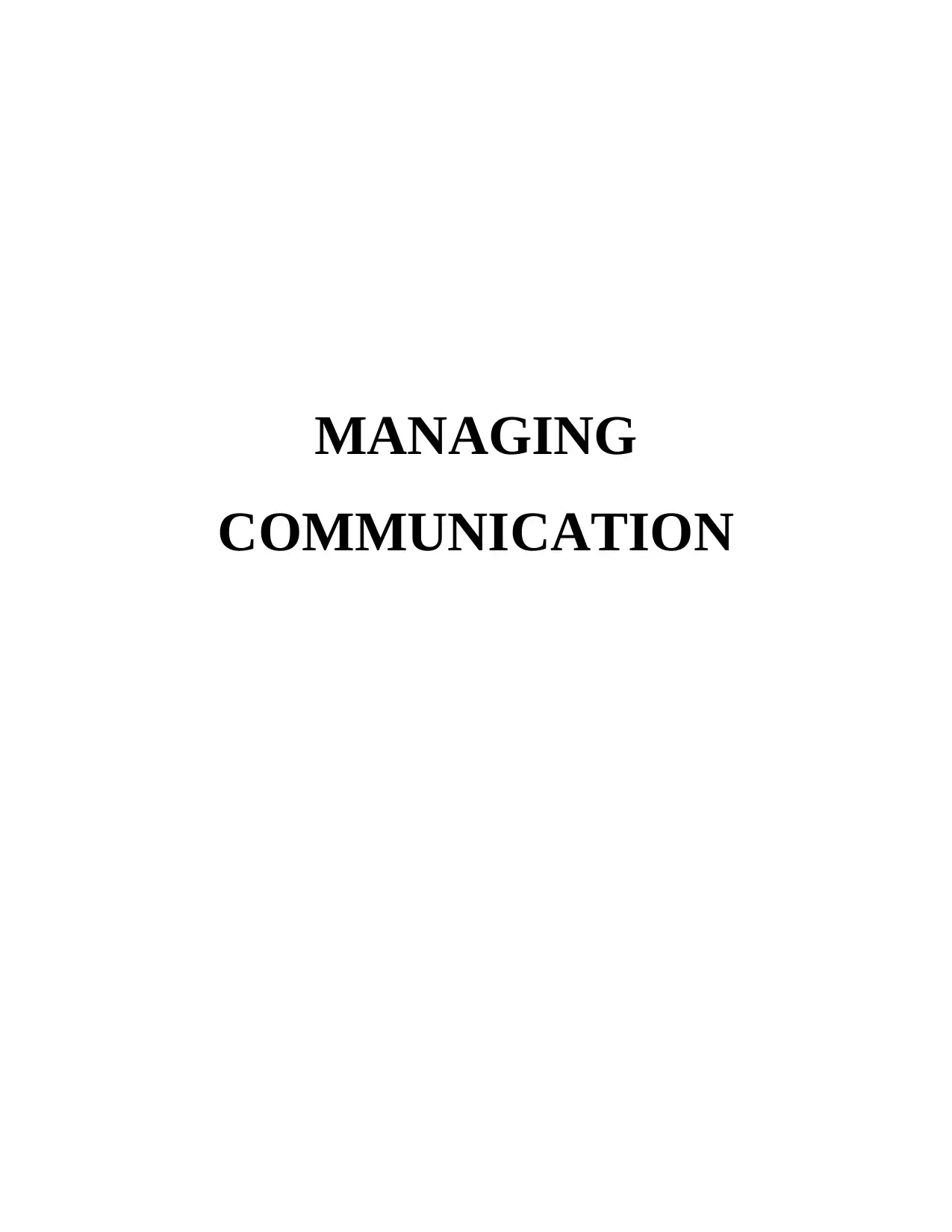
MANAGING
COMMUNICATION
COMMUNICATION
Paraphrase This Document
Need a fresh take? Get an instant paraphrase of this document with our AI Paraphraser
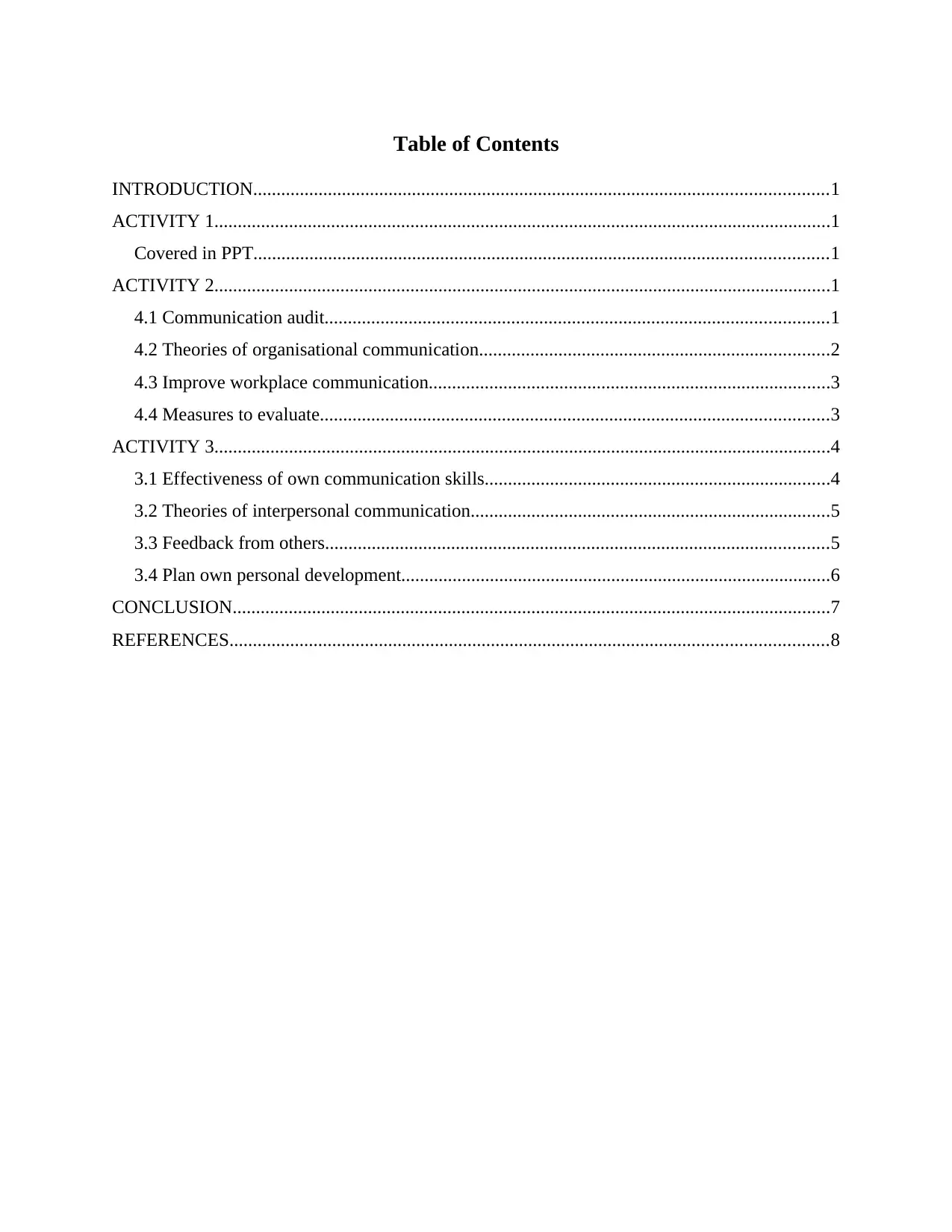
Table of Contents
INTRODUCTION...........................................................................................................................1
ACTIVITY 1....................................................................................................................................1
Covered in PPT...........................................................................................................................1
ACTIVITY 2....................................................................................................................................1
4.1 Communication audit............................................................................................................1
4.2 Theories of organisational communication...........................................................................2
4.3 Improve workplace communication......................................................................................3
4.4 Measures to evaluate.............................................................................................................3
ACTIVITY 3....................................................................................................................................4
3.1 Effectiveness of own communication skills..........................................................................4
3.2 Theories of interpersonal communication.............................................................................5
3.3 Feedback from others............................................................................................................5
3.4 Plan own personal development............................................................................................6
CONCLUSION................................................................................................................................7
REFERENCES................................................................................................................................8
INTRODUCTION...........................................................................................................................1
ACTIVITY 1....................................................................................................................................1
Covered in PPT...........................................................................................................................1
ACTIVITY 2....................................................................................................................................1
4.1 Communication audit............................................................................................................1
4.2 Theories of organisational communication...........................................................................2
4.3 Improve workplace communication......................................................................................3
4.4 Measures to evaluate.............................................................................................................3
ACTIVITY 3....................................................................................................................................4
3.1 Effectiveness of own communication skills..........................................................................4
3.2 Theories of interpersonal communication.............................................................................5
3.3 Feedback from others............................................................................................................5
3.4 Plan own personal development............................................................................................6
CONCLUSION................................................................................................................................7
REFERENCES................................................................................................................................8

⊘ This is a preview!⊘
Do you want full access?
Subscribe today to unlock all pages.

Trusted by 1+ million students worldwide
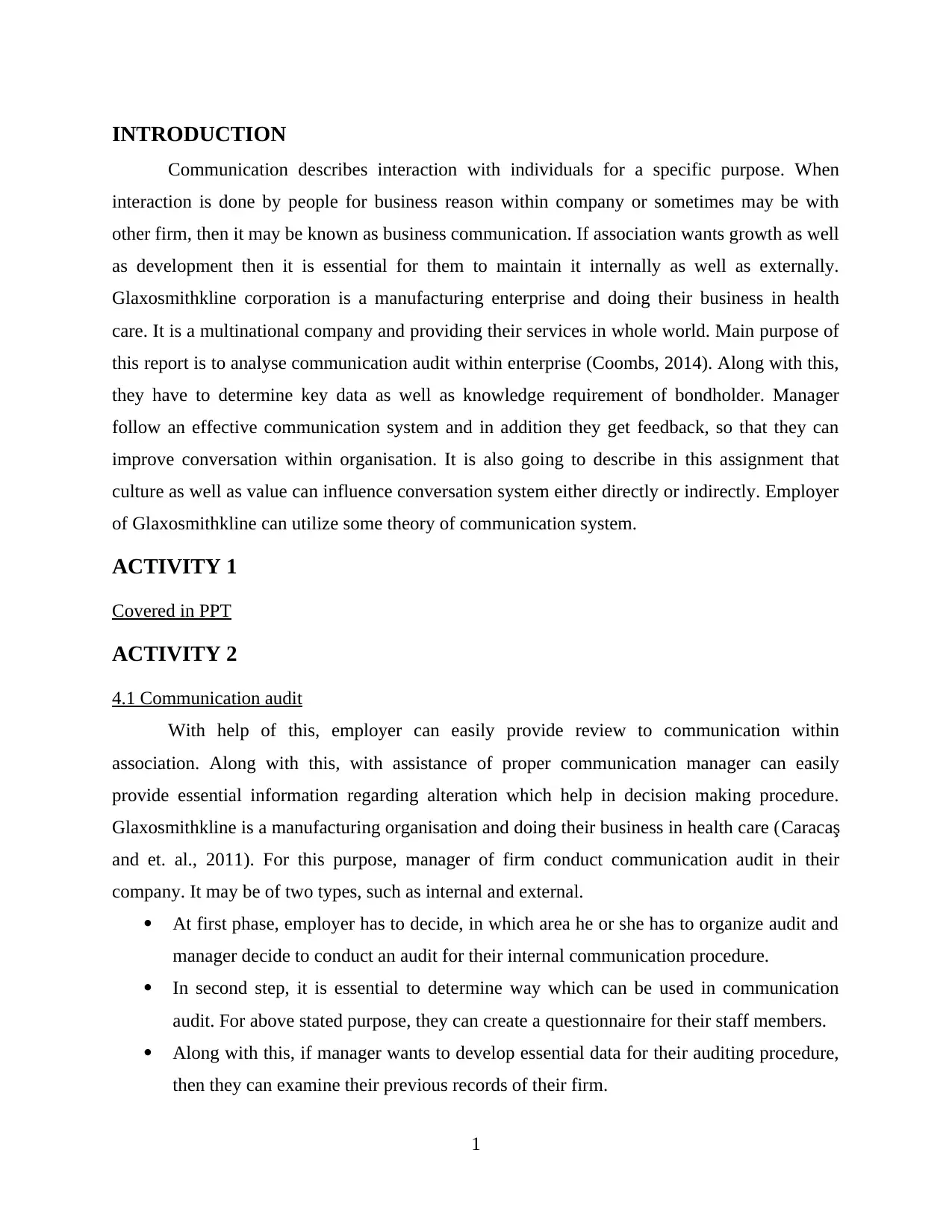
INTRODUCTION
Communication describes interaction with individuals for a specific purpose. When
interaction is done by people for business reason within company or sometimes may be with
other firm, then it may be known as business communication. If association wants growth as well
as development then it is essential for them to maintain it internally as well as externally.
Glaxosmithkline corporation is a manufacturing enterprise and doing their business in health
care. It is a multinational company and providing their services in whole world. Main purpose of
this report is to analyse communication audit within enterprise (Coombs, 2014). Along with this,
they have to determine key data as well as knowledge requirement of bondholder. Manager
follow an effective communication system and in addition they get feedback, so that they can
improve conversation within organisation. It is also going to describe in this assignment that
culture as well as value can influence conversation system either directly or indirectly. Employer
of Glaxosmithkline can utilize some theory of communication system.
ACTIVITY 1
Covered in PPT
ACTIVITY 2
4.1 Communication audit
With help of this, employer can easily provide review to communication within
association. Along with this, with assistance of proper communication manager can easily
provide essential information regarding alteration which help in decision making procedure.
Glaxosmithkline is a manufacturing organisation and doing their business in health care (Caracaş
and et. al., 2011). For this purpose, manager of firm conduct communication audit in their
company. It may be of two types, such as internal and external.
At first phase, employer has to decide, in which area he or she has to organize audit and
manager decide to conduct an audit for their internal communication procedure.
In second step, it is essential to determine way which can be used in communication
audit. For above stated purpose, they can create a questionnaire for their staff members.
Along with this, if manager wants to develop essential data for their auditing procedure,
then they can examine their previous records of their firm.
1
Communication describes interaction with individuals for a specific purpose. When
interaction is done by people for business reason within company or sometimes may be with
other firm, then it may be known as business communication. If association wants growth as well
as development then it is essential for them to maintain it internally as well as externally.
Glaxosmithkline corporation is a manufacturing enterprise and doing their business in health
care. It is a multinational company and providing their services in whole world. Main purpose of
this report is to analyse communication audit within enterprise (Coombs, 2014). Along with this,
they have to determine key data as well as knowledge requirement of bondholder. Manager
follow an effective communication system and in addition they get feedback, so that they can
improve conversation within organisation. It is also going to describe in this assignment that
culture as well as value can influence conversation system either directly or indirectly. Employer
of Glaxosmithkline can utilize some theory of communication system.
ACTIVITY 1
Covered in PPT
ACTIVITY 2
4.1 Communication audit
With help of this, employer can easily provide review to communication within
association. Along with this, with assistance of proper communication manager can easily
provide essential information regarding alteration which help in decision making procedure.
Glaxosmithkline is a manufacturing organisation and doing their business in health care (Caracaş
and et. al., 2011). For this purpose, manager of firm conduct communication audit in their
company. It may be of two types, such as internal and external.
At first phase, employer has to decide, in which area he or she has to organize audit and
manager decide to conduct an audit for their internal communication procedure.
In second step, it is essential to determine way which can be used in communication
audit. For above stated purpose, they can create a questionnaire for their staff members.
Along with this, if manager wants to develop essential data for their auditing procedure,
then they can examine their previous records of their firm.
1
Paraphrase This Document
Need a fresh take? Get an instant paraphrase of this document with our AI Paraphraser
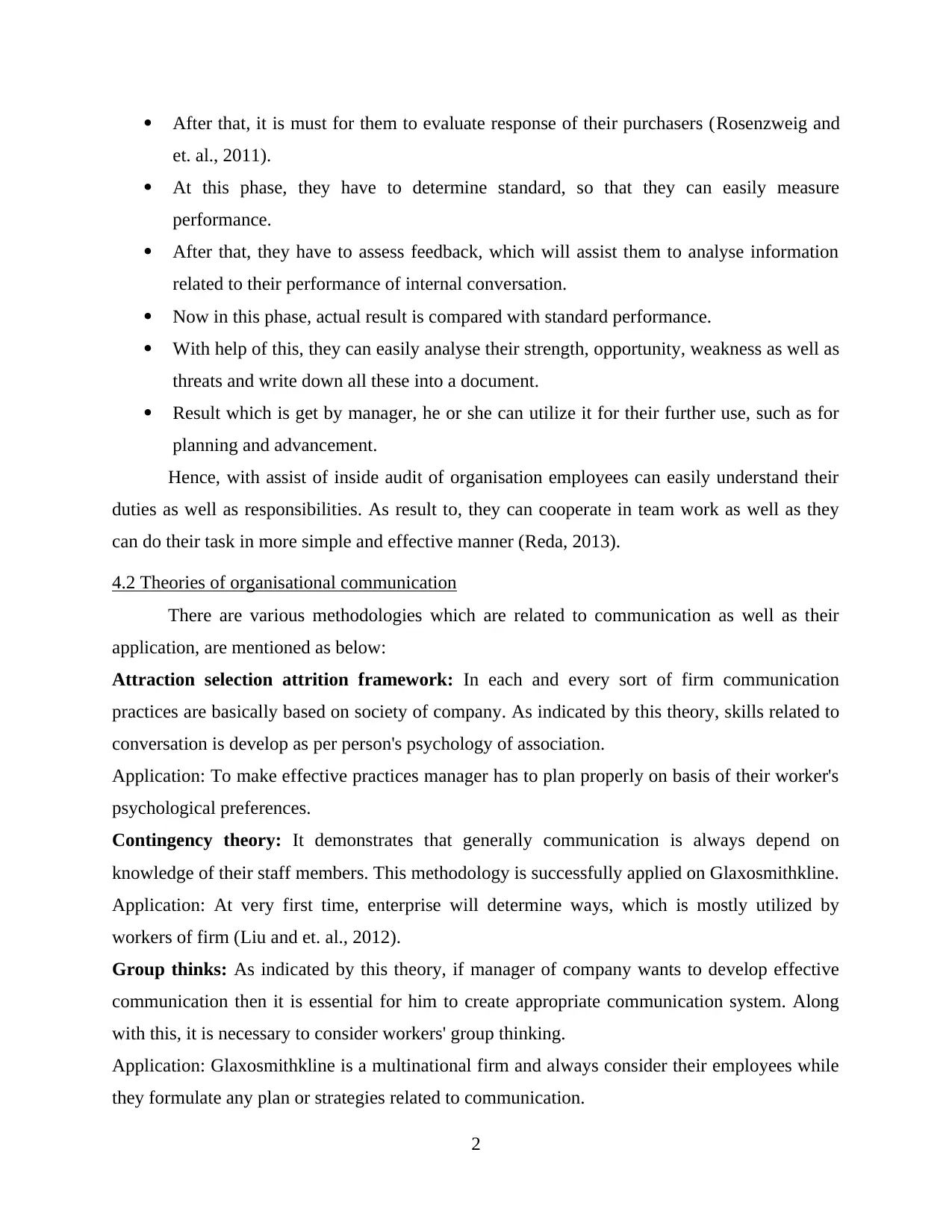
After that, it is must for them to evaluate response of their purchasers (Rosenzweig and
et. al., 2011).
At this phase, they have to determine standard, so that they can easily measure
performance.
After that, they have to assess feedback, which will assist them to analyse information
related to their performance of internal conversation.
Now in this phase, actual result is compared with standard performance.
With help of this, they can easily analyse their strength, opportunity, weakness as well as
threats and write down all these into a document.
Result which is get by manager, he or she can utilize it for their further use, such as for
planning and advancement.
Hence, with assist of inside audit of organisation employees can easily understand their
duties as well as responsibilities. As result to, they can cooperate in team work as well as they
can do their task in more simple and effective manner (Reda, 2013).
4.2 Theories of organisational communication
There are various methodologies which are related to communication as well as their
application, are mentioned as below:
Attraction selection attrition framework: In each and every sort of firm communication
practices are basically based on society of company. As indicated by this theory, skills related to
conversation is develop as per person's psychology of association.
Application: To make effective practices manager has to plan properly on basis of their worker's
psychological preferences.
Contingency theory: It demonstrates that generally communication is always depend on
knowledge of their staff members. This methodology is successfully applied on Glaxosmithkline.
Application: At very first time, enterprise will determine ways, which is mostly utilized by
workers of firm (Liu and et. al., 2012).
Group thinks: As indicated by this theory, if manager of company wants to develop effective
communication then it is essential for him to create appropriate communication system. Along
with this, it is necessary to consider workers' group thinking.
Application: Glaxosmithkline is a multinational firm and always consider their employees while
they formulate any plan or strategies related to communication.
2
et. al., 2011).
At this phase, they have to determine standard, so that they can easily measure
performance.
After that, they have to assess feedback, which will assist them to analyse information
related to their performance of internal conversation.
Now in this phase, actual result is compared with standard performance.
With help of this, they can easily analyse their strength, opportunity, weakness as well as
threats and write down all these into a document.
Result which is get by manager, he or she can utilize it for their further use, such as for
planning and advancement.
Hence, with assist of inside audit of organisation employees can easily understand their
duties as well as responsibilities. As result to, they can cooperate in team work as well as they
can do their task in more simple and effective manner (Reda, 2013).
4.2 Theories of organisational communication
There are various methodologies which are related to communication as well as their
application, are mentioned as below:
Attraction selection attrition framework: In each and every sort of firm communication
practices are basically based on society of company. As indicated by this theory, skills related to
conversation is develop as per person's psychology of association.
Application: To make effective practices manager has to plan properly on basis of their worker's
psychological preferences.
Contingency theory: It demonstrates that generally communication is always depend on
knowledge of their staff members. This methodology is successfully applied on Glaxosmithkline.
Application: At very first time, enterprise will determine ways, which is mostly utilized by
workers of firm (Liu and et. al., 2012).
Group thinks: As indicated by this theory, if manager of company wants to develop effective
communication then it is essential for him to create appropriate communication system. Along
with this, it is necessary to consider workers' group thinking.
Application: Glaxosmithkline is a multinational firm and always consider their employees while
they formulate any plan or strategies related to communication.
2
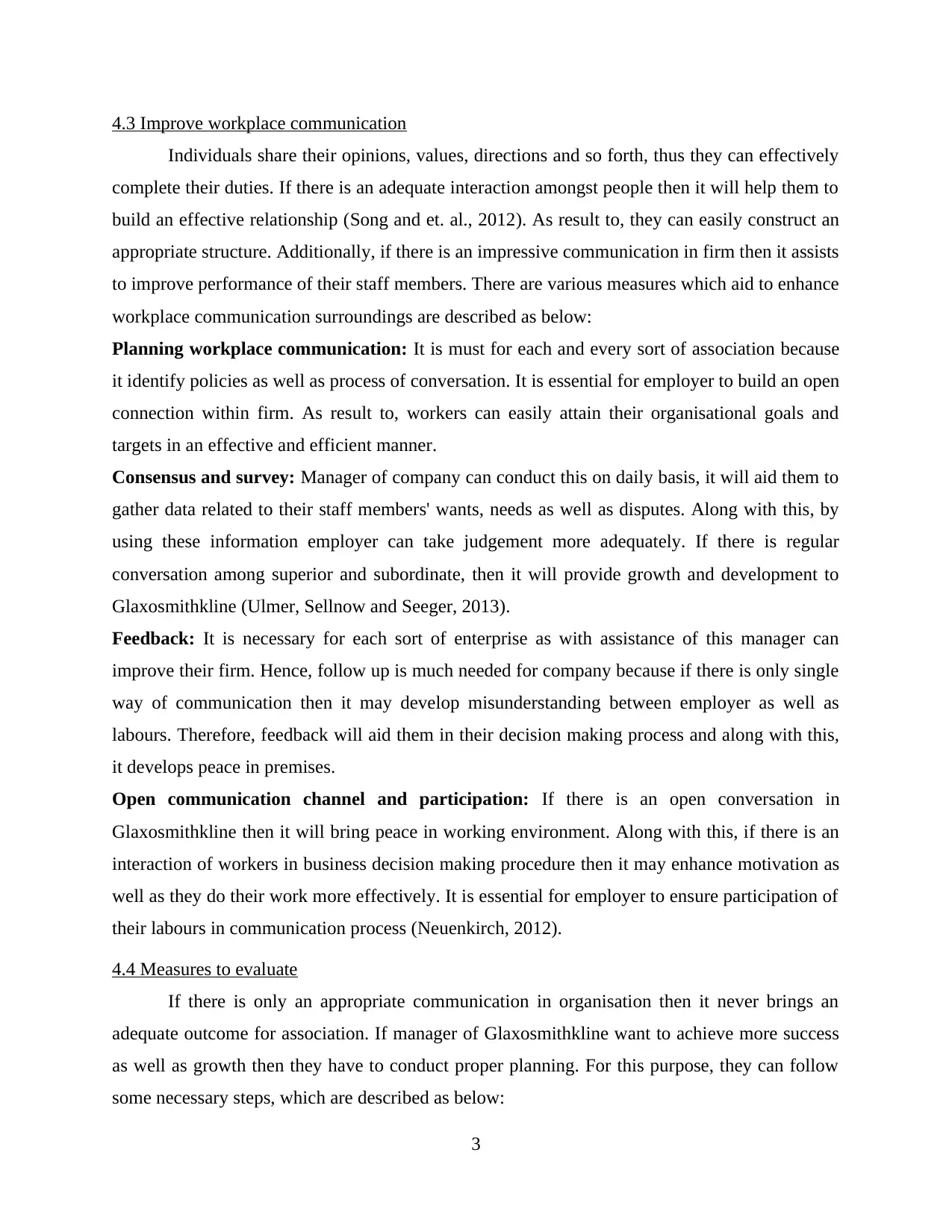
4.3 Improve workplace communication
Individuals share their opinions, values, directions and so forth, thus they can effectively
complete their duties. If there is an adequate interaction amongst people then it will help them to
build an effective relationship (Song and et. al., 2012). As result to, they can easily construct an
appropriate structure. Additionally, if there is an impressive communication in firm then it assists
to improve performance of their staff members. There are various measures which aid to enhance
workplace communication surroundings are described as below:
Planning workplace communication: It is must for each and every sort of association because
it identify policies as well as process of conversation. It is essential for employer to build an open
connection within firm. As result to, workers can easily attain their organisational goals and
targets in an effective and efficient manner.
Consensus and survey: Manager of company can conduct this on daily basis, it will aid them to
gather data related to their staff members' wants, needs as well as disputes. Along with this, by
using these information employer can take judgement more adequately. If there is regular
conversation among superior and subordinate, then it will provide growth and development to
Glaxosmithkline (Ulmer, Sellnow and Seeger, 2013).
Feedback: It is necessary for each sort of enterprise as with assistance of this manager can
improve their firm. Hence, follow up is much needed for company because if there is only single
way of communication then it may develop misunderstanding between employer as well as
labours. Therefore, feedback will aid them in their decision making process and along with this,
it develops peace in premises.
Open communication channel and participation: If there is an open conversation in
Glaxosmithkline then it will bring peace in working environment. Along with this, if there is an
interaction of workers in business decision making procedure then it may enhance motivation as
well as they do their work more effectively. It is essential for employer to ensure participation of
their labours in communication process (Neuenkirch, 2012).
4.4 Measures to evaluate
If there is only an appropriate communication in organisation then it never brings an
adequate outcome for association. If manager of Glaxosmithkline want to achieve more success
as well as growth then they have to conduct proper planning. For this purpose, they can follow
some necessary steps, which are described as below:
3
Individuals share their opinions, values, directions and so forth, thus they can effectively
complete their duties. If there is an adequate interaction amongst people then it will help them to
build an effective relationship (Song and et. al., 2012). As result to, they can easily construct an
appropriate structure. Additionally, if there is an impressive communication in firm then it assists
to improve performance of their staff members. There are various measures which aid to enhance
workplace communication surroundings are described as below:
Planning workplace communication: It is must for each and every sort of association because
it identify policies as well as process of conversation. It is essential for employer to build an open
connection within firm. As result to, workers can easily attain their organisational goals and
targets in an effective and efficient manner.
Consensus and survey: Manager of company can conduct this on daily basis, it will aid them to
gather data related to their staff members' wants, needs as well as disputes. Along with this, by
using these information employer can take judgement more adequately. If there is regular
conversation among superior and subordinate, then it will provide growth and development to
Glaxosmithkline (Ulmer, Sellnow and Seeger, 2013).
Feedback: It is necessary for each sort of enterprise as with assistance of this manager can
improve their firm. Hence, follow up is much needed for company because if there is only single
way of communication then it may develop misunderstanding between employer as well as
labours. Therefore, feedback will aid them in their decision making process and along with this,
it develops peace in premises.
Open communication channel and participation: If there is an open conversation in
Glaxosmithkline then it will bring peace in working environment. Along with this, if there is an
interaction of workers in business decision making procedure then it may enhance motivation as
well as they do their work more effectively. It is essential for employer to ensure participation of
their labours in communication process (Neuenkirch, 2012).
4.4 Measures to evaluate
If there is only an appropriate communication in organisation then it never brings an
adequate outcome for association. If manager of Glaxosmithkline want to achieve more success
as well as growth then they have to conduct proper planning. For this purpose, they can follow
some necessary steps, which are described as below:
3
⊘ This is a preview!⊘
Do you want full access?
Subscribe today to unlock all pages.

Trusted by 1+ million students worldwide
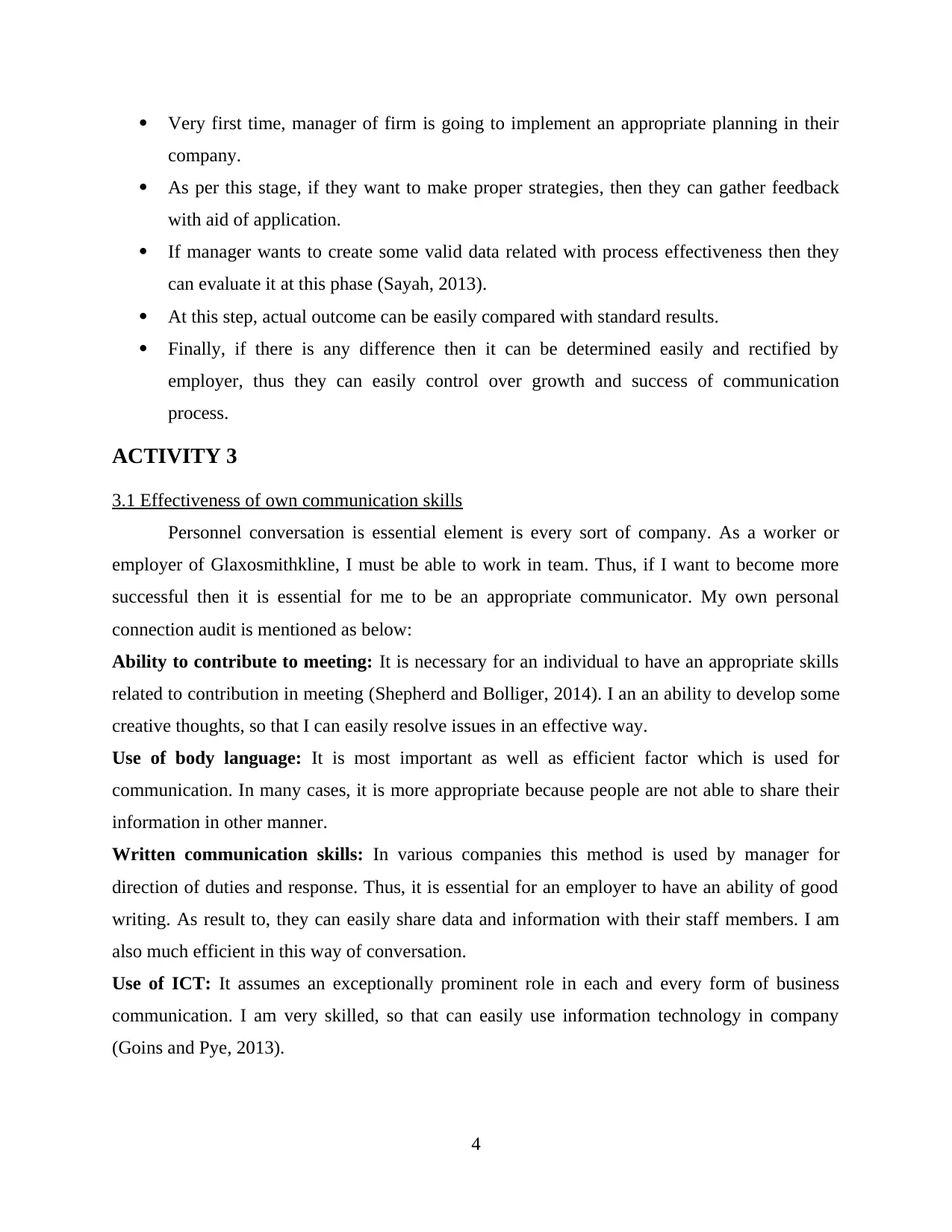
Very first time, manager of firm is going to implement an appropriate planning in their
company.
As per this stage, if they want to make proper strategies, then they can gather feedback
with aid of application.
If manager wants to create some valid data related with process effectiveness then they
can evaluate it at this phase (Sayah, 2013).
At this step, actual outcome can be easily compared with standard results.
Finally, if there is any difference then it can be determined easily and rectified by
employer, thus they can easily control over growth and success of communication
process.
ACTIVITY 3
3.1 Effectiveness of own communication skills
Personnel conversation is essential element is every sort of company. As a worker or
employer of Glaxosmithkline, I must be able to work in team. Thus, if I want to become more
successful then it is essential for me to be an appropriate communicator. My own personal
connection audit is mentioned as below:
Ability to contribute to meeting: It is necessary for an individual to have an appropriate skills
related to contribution in meeting (Shepherd and Bolliger, 2014). I an an ability to develop some
creative thoughts, so that I can easily resolve issues in an effective way.
Use of body language: It is most important as well as efficient factor which is used for
communication. In many cases, it is more appropriate because people are not able to share their
information in other manner.
Written communication skills: In various companies this method is used by manager for
direction of duties and response. Thus, it is essential for an employer to have an ability of good
writing. As result to, they can easily share data and information with their staff members. I am
also much efficient in this way of conversation.
Use of ICT: It assumes an exceptionally prominent role in each and every form of business
communication. I am very skilled, so that can easily use information technology in company
(Goins and Pye, 2013).
4
company.
As per this stage, if they want to make proper strategies, then they can gather feedback
with aid of application.
If manager wants to create some valid data related with process effectiveness then they
can evaluate it at this phase (Sayah, 2013).
At this step, actual outcome can be easily compared with standard results.
Finally, if there is any difference then it can be determined easily and rectified by
employer, thus they can easily control over growth and success of communication
process.
ACTIVITY 3
3.1 Effectiveness of own communication skills
Personnel conversation is essential element is every sort of company. As a worker or
employer of Glaxosmithkline, I must be able to work in team. Thus, if I want to become more
successful then it is essential for me to be an appropriate communicator. My own personal
connection audit is mentioned as below:
Ability to contribute to meeting: It is necessary for an individual to have an appropriate skills
related to contribution in meeting (Shepherd and Bolliger, 2014). I an an ability to develop some
creative thoughts, so that I can easily resolve issues in an effective way.
Use of body language: It is most important as well as efficient factor which is used for
communication. In many cases, it is more appropriate because people are not able to share their
information in other manner.
Written communication skills: In various companies this method is used by manager for
direction of duties and response. Thus, it is essential for an employer to have an ability of good
writing. As result to, they can easily share data and information with their staff members. I am
also much efficient in this way of conversation.
Use of ICT: It assumes an exceptionally prominent role in each and every form of business
communication. I am very skilled, so that can easily use information technology in company
(Goins and Pye, 2013).
4
Paraphrase This Document
Need a fresh take? Get an instant paraphrase of this document with our AI Paraphraser
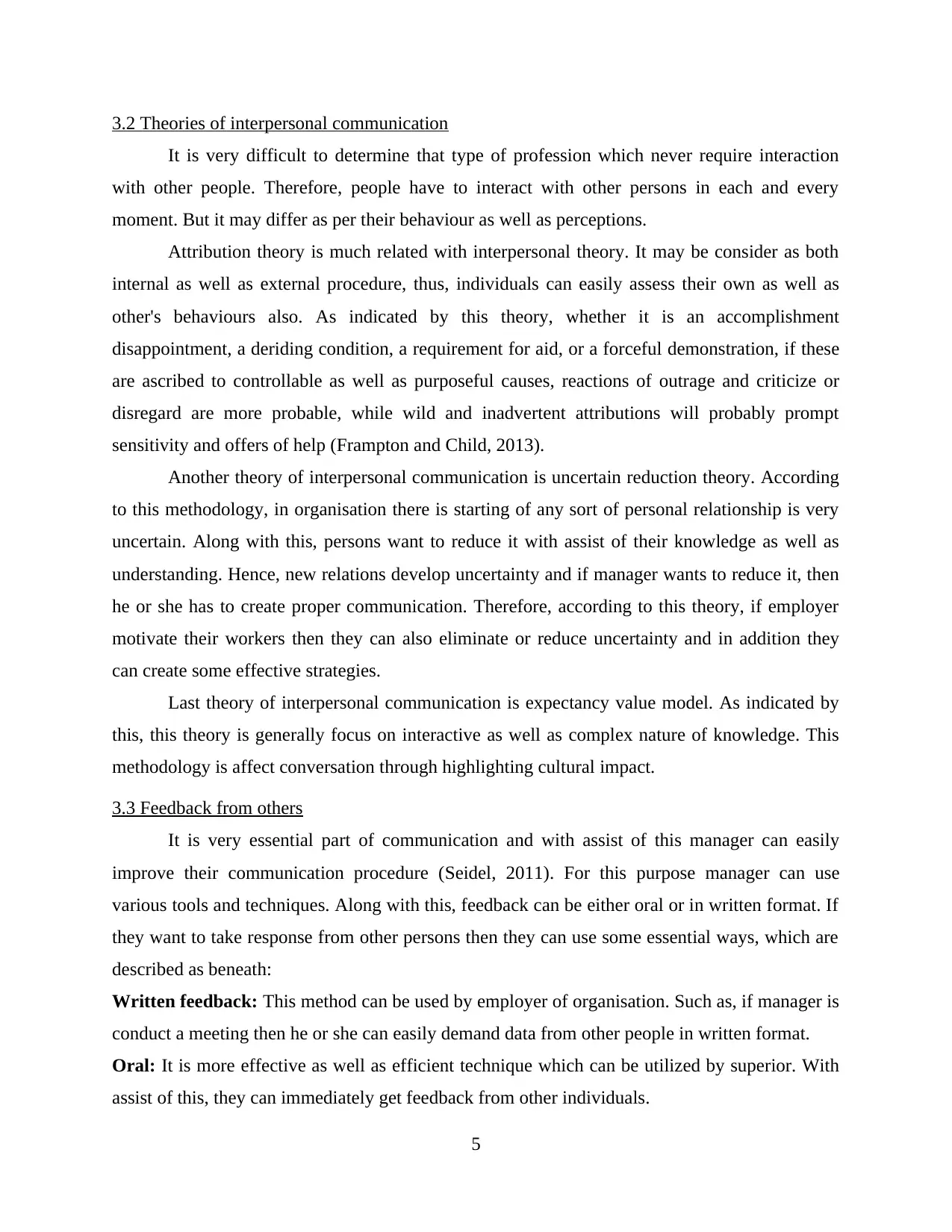
3.2 Theories of interpersonal communication
It is very difficult to determine that type of profession which never require interaction
with other people. Therefore, people have to interact with other persons in each and every
moment. But it may differ as per their behaviour as well as perceptions.
Attribution theory is much related with interpersonal theory. It may be consider as both
internal as well as external procedure, thus, individuals can easily assess their own as well as
other's behaviours also. As indicated by this theory, whether it is an accomplishment
disappointment, a deriding condition, a requirement for aid, or a forceful demonstration, if these
are ascribed to controllable as well as purposeful causes, reactions of outrage and criticize or
disregard are more probable, while wild and inadvertent attributions will probably prompt
sensitivity and offers of help (Frampton and Child, 2013).
Another theory of interpersonal communication is uncertain reduction theory. According
to this methodology, in organisation there is starting of any sort of personal relationship is very
uncertain. Along with this, persons want to reduce it with assist of their knowledge as well as
understanding. Hence, new relations develop uncertainty and if manager wants to reduce it, then
he or she has to create proper communication. Therefore, according to this theory, if employer
motivate their workers then they can also eliminate or reduce uncertainty and in addition they
can create some effective strategies.
Last theory of interpersonal communication is expectancy value model. As indicated by
this, this theory is generally focus on interactive as well as complex nature of knowledge. This
methodology is affect conversation through highlighting cultural impact.
3.3 Feedback from others
It is very essential part of communication and with assist of this manager can easily
improve their communication procedure (Seidel, 2011). For this purpose manager can use
various tools and techniques. Along with this, feedback can be either oral or in written format. If
they want to take response from other persons then they can use some essential ways, which are
described as beneath:
Written feedback: This method can be used by employer of organisation. Such as, if manager is
conduct a meeting then he or she can easily demand data from other people in written format.
Oral: It is more effective as well as efficient technique which can be utilized by superior. With
assist of this, they can immediately get feedback from other individuals.
5
It is very difficult to determine that type of profession which never require interaction
with other people. Therefore, people have to interact with other persons in each and every
moment. But it may differ as per their behaviour as well as perceptions.
Attribution theory is much related with interpersonal theory. It may be consider as both
internal as well as external procedure, thus, individuals can easily assess their own as well as
other's behaviours also. As indicated by this theory, whether it is an accomplishment
disappointment, a deriding condition, a requirement for aid, or a forceful demonstration, if these
are ascribed to controllable as well as purposeful causes, reactions of outrage and criticize or
disregard are more probable, while wild and inadvertent attributions will probably prompt
sensitivity and offers of help (Frampton and Child, 2013).
Another theory of interpersonal communication is uncertain reduction theory. According
to this methodology, in organisation there is starting of any sort of personal relationship is very
uncertain. Along with this, persons want to reduce it with assist of their knowledge as well as
understanding. Hence, new relations develop uncertainty and if manager wants to reduce it, then
he or she has to create proper communication. Therefore, according to this theory, if employer
motivate their workers then they can also eliminate or reduce uncertainty and in addition they
can create some effective strategies.
Last theory of interpersonal communication is expectancy value model. As indicated by
this, this theory is generally focus on interactive as well as complex nature of knowledge. This
methodology is affect conversation through highlighting cultural impact.
3.3 Feedback from others
It is very essential part of communication and with assist of this manager can easily
improve their communication procedure (Seidel, 2011). For this purpose manager can use
various tools and techniques. Along with this, feedback can be either oral or in written format. If
they want to take response from other persons then they can use some essential ways, which are
described as beneath:
Written feedback: This method can be used by employer of organisation. Such as, if manager is
conduct a meeting then he or she can easily demand data from other people in written format.
Oral: It is more effective as well as efficient technique which can be utilized by superior. With
assist of this, they can immediately get feedback from other individuals.
5
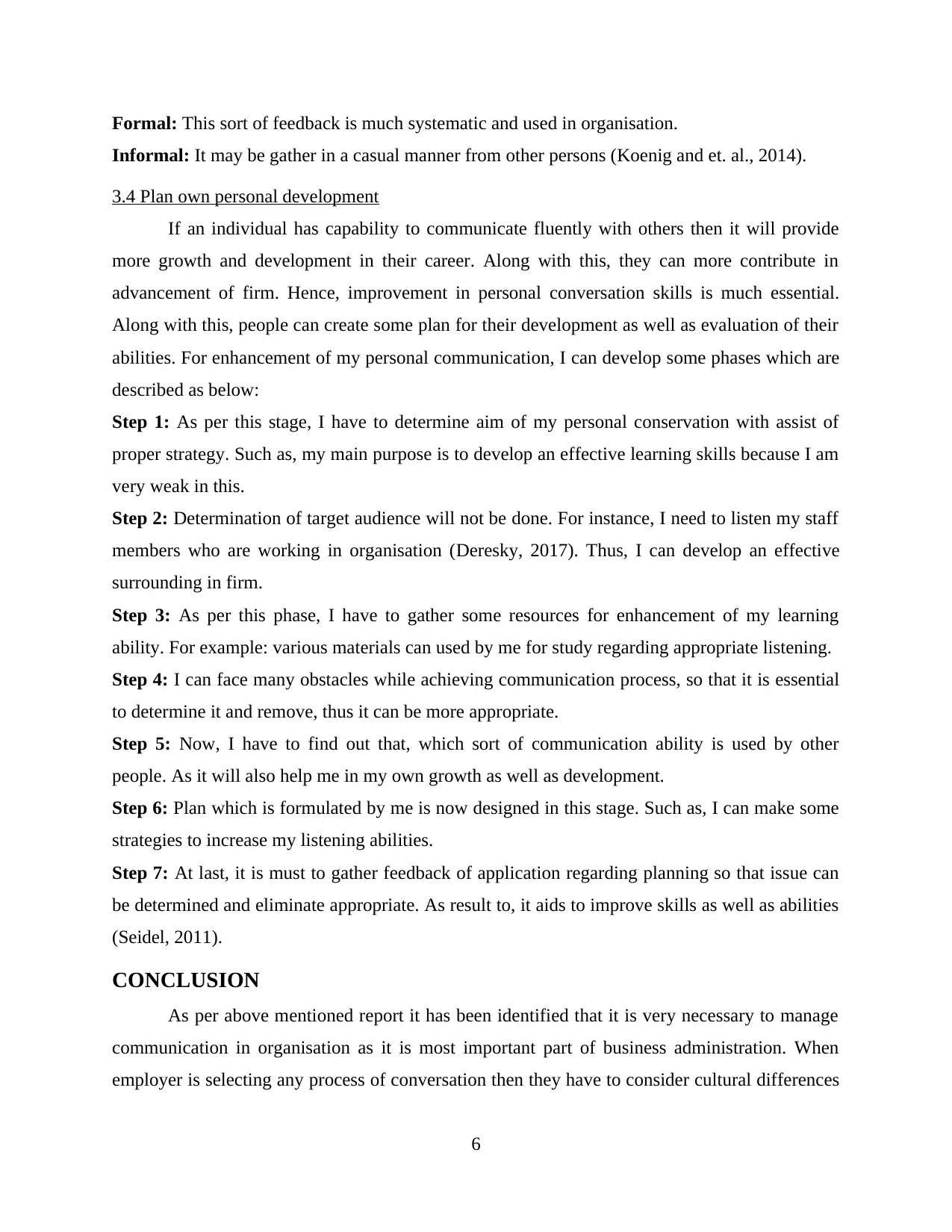
Formal: This sort of feedback is much systematic and used in organisation.
Informal: It may be gather in a casual manner from other persons (Koenig and et. al., 2014).
3.4 Plan own personal development
If an individual has capability to communicate fluently with others then it will provide
more growth and development in their career. Along with this, they can more contribute in
advancement of firm. Hence, improvement in personal conversation skills is much essential.
Along with this, people can create some plan for their development as well as evaluation of their
abilities. For enhancement of my personal communication, I can develop some phases which are
described as below:
Step 1: As per this stage, I have to determine aim of my personal conservation with assist of
proper strategy. Such as, my main purpose is to develop an effective learning skills because I am
very weak in this.
Step 2: Determination of target audience will not be done. For instance, I need to listen my staff
members who are working in organisation (Deresky, 2017). Thus, I can develop an effective
surrounding in firm.
Step 3: As per this phase, I have to gather some resources for enhancement of my learning
ability. For example: various materials can used by me for study regarding appropriate listening.
Step 4: I can face many obstacles while achieving communication process, so that it is essential
to determine it and remove, thus it can be more appropriate.
Step 5: Now, I have to find out that, which sort of communication ability is used by other
people. As it will also help me in my own growth as well as development.
Step 6: Plan which is formulated by me is now designed in this stage. Such as, I can make some
strategies to increase my listening abilities.
Step 7: At last, it is must to gather feedback of application regarding planning so that issue can
be determined and eliminate appropriate. As result to, it aids to improve skills as well as abilities
(Seidel, 2011).
CONCLUSION
As per above mentioned report it has been identified that it is very necessary to manage
communication in organisation as it is most important part of business administration. When
employer is selecting any process of conversation then they have to consider cultural differences
6
Informal: It may be gather in a casual manner from other persons (Koenig and et. al., 2014).
3.4 Plan own personal development
If an individual has capability to communicate fluently with others then it will provide
more growth and development in their career. Along with this, they can more contribute in
advancement of firm. Hence, improvement in personal conversation skills is much essential.
Along with this, people can create some plan for their development as well as evaluation of their
abilities. For enhancement of my personal communication, I can develop some phases which are
described as below:
Step 1: As per this stage, I have to determine aim of my personal conservation with assist of
proper strategy. Such as, my main purpose is to develop an effective learning skills because I am
very weak in this.
Step 2: Determination of target audience will not be done. For instance, I need to listen my staff
members who are working in organisation (Deresky, 2017). Thus, I can develop an effective
surrounding in firm.
Step 3: As per this phase, I have to gather some resources for enhancement of my learning
ability. For example: various materials can used by me for study regarding appropriate listening.
Step 4: I can face many obstacles while achieving communication process, so that it is essential
to determine it and remove, thus it can be more appropriate.
Step 5: Now, I have to find out that, which sort of communication ability is used by other
people. As it will also help me in my own growth as well as development.
Step 6: Plan which is formulated by me is now designed in this stage. Such as, I can make some
strategies to increase my listening abilities.
Step 7: At last, it is must to gather feedback of application regarding planning so that issue can
be determined and eliminate appropriate. As result to, it aids to improve skills as well as abilities
(Seidel, 2011).
CONCLUSION
As per above mentioned report it has been identified that it is very necessary to manage
communication in organisation as it is most important part of business administration. When
employer is selecting any process of conversation then they have to consider cultural differences
6
⊘ This is a preview!⊘
Do you want full access?
Subscribe today to unlock all pages.

Trusted by 1+ million students worldwide
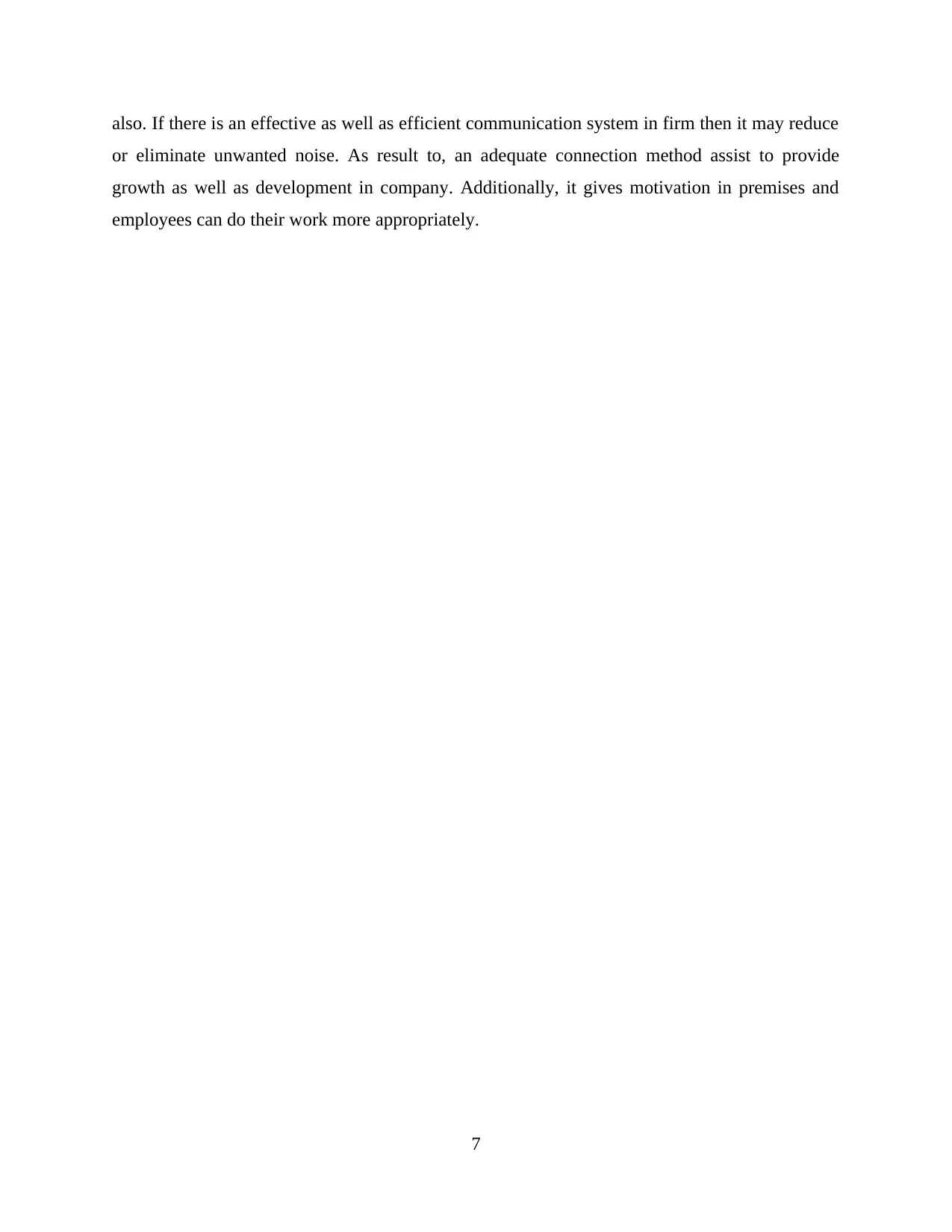
also. If there is an effective as well as efficient communication system in firm then it may reduce
or eliminate unwanted noise. As result to, an adequate connection method assist to provide
growth as well as development in company. Additionally, it gives motivation in premises and
employees can do their work more appropriately.
7
or eliminate unwanted noise. As result to, an adequate connection method assist to provide
growth as well as development in company. Additionally, it gives motivation in premises and
employees can do their work more appropriately.
7
Paraphrase This Document
Need a fresh take? Get an instant paraphrase of this document with our AI Paraphraser
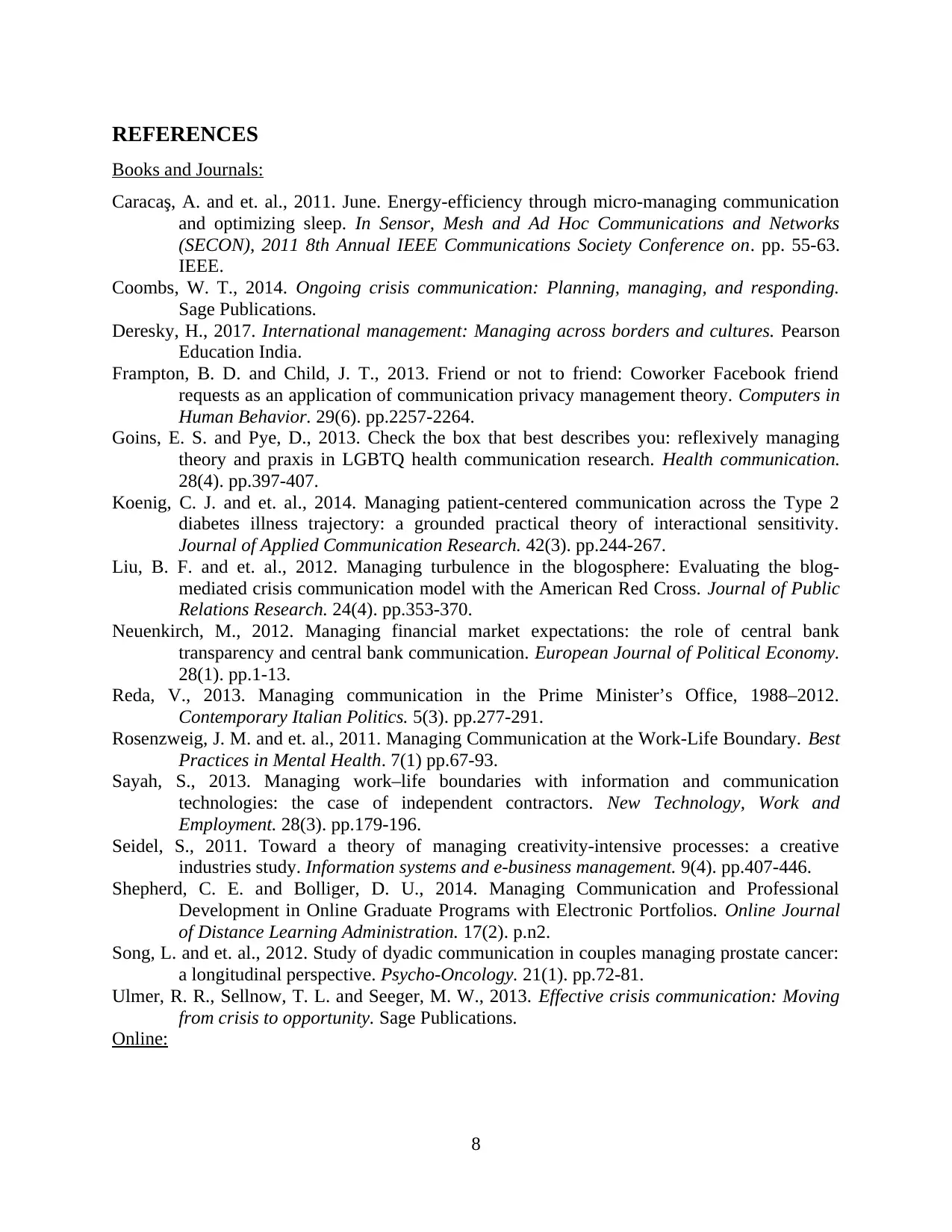
REFERENCES
Books and Journals:
Caracaş, A. and et. al., 2011. June. Energy-efficiency through micro-managing communication
and optimizing sleep. In Sensor, Mesh and Ad Hoc Communications and Networks
(SECON), 2011 8th Annual IEEE Communications Society Conference on. pp. 55-63.
IEEE.
Coombs, W. T., 2014. Ongoing crisis communication: Planning, managing, and responding.
Sage Publications.
Deresky, H., 2017. International management: Managing across borders and cultures. Pearson
Education India.
Frampton, B. D. and Child, J. T., 2013. Friend or not to friend: Coworker Facebook friend
requests as an application of communication privacy management theory. Computers in
Human Behavior. 29(6). pp.2257-2264.
Goins, E. S. and Pye, D., 2013. Check the box that best describes you: reflexively managing
theory and praxis in LGBTQ health communication research. Health communication.
28(4). pp.397-407.
Koenig, C. J. and et. al., 2014. Managing patient-centered communication across the Type 2
diabetes illness trajectory: a grounded practical theory of interactional sensitivity.
Journal of Applied Communication Research. 42(3). pp.244-267.
Liu, B. F. and et. al., 2012. Managing turbulence in the blogosphere: Evaluating the blog-
mediated crisis communication model with the American Red Cross. Journal of Public
Relations Research. 24(4). pp.353-370.
Neuenkirch, M., 2012. Managing financial market expectations: the role of central bank
transparency and central bank communication. European Journal of Political Economy.
28(1). pp.1-13.
Reda, V., 2013. Managing communication in the Prime Minister’s Office, 1988–2012.
Contemporary Italian Politics. 5(3). pp.277-291.
Rosenzweig, J. M. and et. al., 2011. Managing Communication at the Work-Life Boundary. Best
Practices in Mental Health. 7(1) pp.67-93.
Sayah, S., 2013. Managing work–life boundaries with information and communication
technologies: the case of independent contractors. New Technology, Work and
Employment. 28(3). pp.179-196.
Seidel, S., 2011. Toward a theory of managing creativity-intensive processes: a creative
industries study. Information systems and e-business management. 9(4). pp.407-446.
Shepherd, C. E. and Bolliger, D. U., 2014. Managing Communication and Professional
Development in Online Graduate Programs with Electronic Portfolios. Online Journal
of Distance Learning Administration. 17(2). p.n2.
Song, L. and et. al., 2012. Study of dyadic communication in couples managing prostate cancer:
a longitudinal perspective. Psycho‐Oncology. 21(1). pp.72-81.
Ulmer, R. R., Sellnow, T. L. and Seeger, M. W., 2013. Effective crisis communication: Moving
from crisis to opportunity. Sage Publications.
Online:
8
Books and Journals:
Caracaş, A. and et. al., 2011. June. Energy-efficiency through micro-managing communication
and optimizing sleep. In Sensor, Mesh and Ad Hoc Communications and Networks
(SECON), 2011 8th Annual IEEE Communications Society Conference on. pp. 55-63.
IEEE.
Coombs, W. T., 2014. Ongoing crisis communication: Planning, managing, and responding.
Sage Publications.
Deresky, H., 2017. International management: Managing across borders and cultures. Pearson
Education India.
Frampton, B. D. and Child, J. T., 2013. Friend or not to friend: Coworker Facebook friend
requests as an application of communication privacy management theory. Computers in
Human Behavior. 29(6). pp.2257-2264.
Goins, E. S. and Pye, D., 2013. Check the box that best describes you: reflexively managing
theory and praxis in LGBTQ health communication research. Health communication.
28(4). pp.397-407.
Koenig, C. J. and et. al., 2014. Managing patient-centered communication across the Type 2
diabetes illness trajectory: a grounded practical theory of interactional sensitivity.
Journal of Applied Communication Research. 42(3). pp.244-267.
Liu, B. F. and et. al., 2012. Managing turbulence in the blogosphere: Evaluating the blog-
mediated crisis communication model with the American Red Cross. Journal of Public
Relations Research. 24(4). pp.353-370.
Neuenkirch, M., 2012. Managing financial market expectations: the role of central bank
transparency and central bank communication. European Journal of Political Economy.
28(1). pp.1-13.
Reda, V., 2013. Managing communication in the Prime Minister’s Office, 1988–2012.
Contemporary Italian Politics. 5(3). pp.277-291.
Rosenzweig, J. M. and et. al., 2011. Managing Communication at the Work-Life Boundary. Best
Practices in Mental Health. 7(1) pp.67-93.
Sayah, S., 2013. Managing work–life boundaries with information and communication
technologies: the case of independent contractors. New Technology, Work and
Employment. 28(3). pp.179-196.
Seidel, S., 2011. Toward a theory of managing creativity-intensive processes: a creative
industries study. Information systems and e-business management. 9(4). pp.407-446.
Shepherd, C. E. and Bolliger, D. U., 2014. Managing Communication and Professional
Development in Online Graduate Programs with Electronic Portfolios. Online Journal
of Distance Learning Administration. 17(2). p.n2.
Song, L. and et. al., 2012. Study of dyadic communication in couples managing prostate cancer:
a longitudinal perspective. Psycho‐Oncology. 21(1). pp.72-81.
Ulmer, R. R., Sellnow, T. L. and Seeger, M. W., 2013. Effective crisis communication: Moving
from crisis to opportunity. Sage Publications.
Online:
8
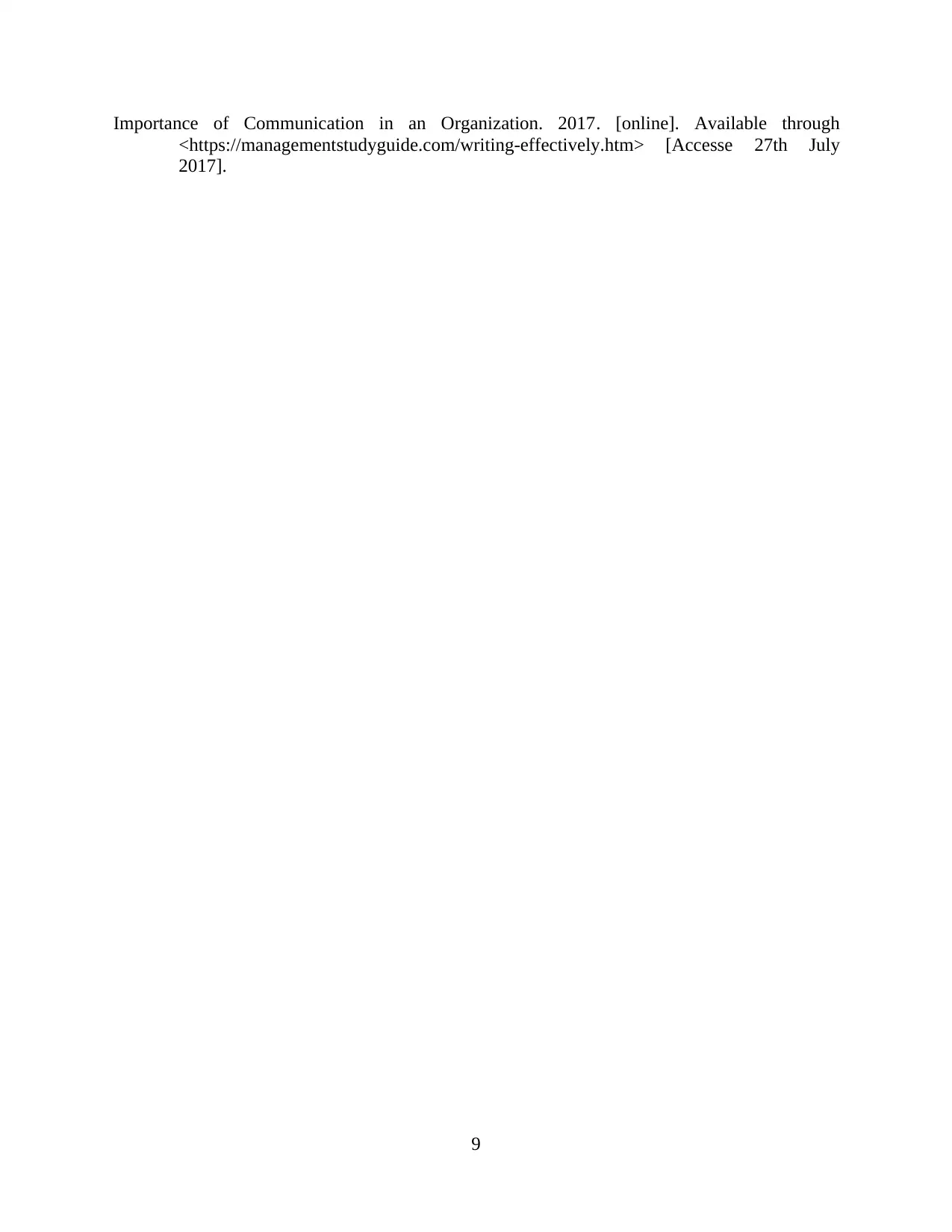
Importance of Communication in an Organization. 2017. [online]. Available through
<https://managementstudyguide.com/writing-effectively.htm> [Accesse 27th July
2017].
9
<https://managementstudyguide.com/writing-effectively.htm> [Accesse 27th July
2017].
9
⊘ This is a preview!⊘
Do you want full access?
Subscribe today to unlock all pages.

Trusted by 1+ million students worldwide
1 out of 12
Related Documents
Your All-in-One AI-Powered Toolkit for Academic Success.
+13062052269
info@desklib.com
Available 24*7 on WhatsApp / Email
![[object Object]](/_next/static/media/star-bottom.7253800d.svg)
Unlock your academic potential
Copyright © 2020–2025 A2Z Services. All Rights Reserved. Developed and managed by ZUCOL.





